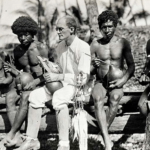We explain what exploratory research is, its characteristics, types and methods. Also, its advantages, disadvantages and how to do one step by step, with examples.

What is exploratory research?
An exploratory investigation It is a type of research that is carried out when you want to study a new topic or about which there is little information. It also serves when an object of study is not completely defined and specialists need to know the phenomenon better.
The main objective of exploratory research is, precisely, explore a topic to gain an initial understanding. The aim is to identify the most important variables, propose hypotheses, discover general patterns and preliminary relationships that can be addressed in greater depth in subsequent studies.
Exploratory research usually have a flexible and adaptable methodology willing to mold itself as the investigation progresses. They can use all types of tools and instruments, such as interviews, surveys, observations, literature reviews and case studies.
This kind of research is very common in all types of disciplines. For example, in sociology it is used to address new social behaviors, and in marketing, to recognize consumer trends. In health sciences, exploratory research is applied to examine new diseases, and in environmental sciences, to analyze the impact of human activity on an ecosystem.
Characteristics of exploratory research
Among the main characteristics of exploratory research are:
- Open goal. It is dedicated to exploring a little-known topic or phenomenon, generating new ideas, identifying patterns, and formulating research questions.
- Preliminary nature. Their findings are not definitive, but rather generate basic knowledge that must be deepened and made more complex in future research.
- Flexibility. It uses an adaptable methodology that allows modifications during the development of the research.
- Innovation. It facilitates the identification of new phenomena or relationships that had not been considered.
- Limited scope. It produces general knowledge without going into details, causal relationships or variables.
See also: Research
Types of exploratory research
Different types of exploratory research are carried out in different disciplines, depending on the phenomenon sought to be analyzed and the purpose of the study.
- Theoretical exploratory research. It seeks to develop new theories or concepts in under-researched areas. For example, a group of political scientists analyzing the influence of social networks on electoral behavior finds few previous studies and decides to carry out exploratory research.
- Practical exploratory research. Solutions are sought for specific problems in a real context. For example, faced with a sustained bullying problem in a school, educators decide to carry out exploratory research to look for new teaching methods on respect among peers.
- Empirical exploratory research Data is analyzed to discover patterns or trends in understudied phenomena. For example, it is decided to investigate the presence of organic molecules on a moon of Jupiter, so a team of astronomers carries out an exploratory study to analyze the chemical composition of the atmosphere and define the possibility of further research.
Exploratory research methods

In exploratory research, different study methods are used, which are common to other types of research. However, in this case It is essential to have an open and flexible methodological approach which allows the work tools to be adapted as the study progresses. The objective is always to explore and develop knowledge, and it is possible that new tools will need to be incorporated along the way.
Likewise, tools intended for qualitative analysis are usually preferred rather than quantitative, because they allow a deeper and more detailed understanding of little-known phenomena.
Among the tools used in exploratory research are:
- Open interview. This is an unstructured interview, where the researcher asks open-ended questions to explore the participant's perceptions and experiences.
- Focus group. Meetings are held with a small group of people, guided by a moderator who proposes activities to discuss and explore opinions on a specific topic.
- Literature review. Studies, articles and documents on a topic are analyzed to identify what knowledge does not yet exist or what research needs to be done.
- Case study. A detailed examination of a specific case is done to obtain a deep understanding of a particular phenomenon.
- Content analysis. Different types of sources are studied to identify themes, patterns or trends in the content and knowledge generated on a topic.
- Preliminary experimentation. Basic experiments or pilot tests are done to explore the influence of specific variables on a phenomenon and then design more complex studies.
- Pilot survey. Although a survey is usually a quantitative methodology, in the exploratory phase it can be used on a pilot basis to collect preliminary data.
- Conceptual mapping. A conceptual diagram is made to visualize and organize related concepts and ideas.
See also: Research techniques
How to carry out exploratory research?
To carry out exploratory research, it is important to keep in mind that the purpose is to discover new elements of a little-known topic and that it is necessary to maintain an action plan that can be adapted as the project progresses. However, the following key steps can be established to carry out an exploratory research:
- Define the topic or problem Determine the phenomenon to explore and formulate a broad research question that can be adapted to new findings.
- Review previous knowledge Check existing studies to understand the context of the topic and identify what knowledge has not yet been developed.
- Choose the methodology. Analyze what methods are appropriate for the research and design the necessary instruments (such as surveys, observation guides or forms).
- Collect data. Carry out field work and collect the necessary data.
- Observe preliminary conclusions. Analyze the information obtained and identify ideas, patterns and possible explanations for the phenomenon studied.
- Adjust focus. Based on the preliminary conclusions, adjust the methodology or redefine the research problem, if necessary.
- Document the results. Prepare a report on the research process, findings, limitations and recommendations for future work.
Advantages and disadvantages of exploratory research
Among the advantages and disadvantages of exploratory research, we can highlight:
| Advantages | Disadvantages | |
|---|---|---|
| Aim | It allows you to identify little-known problems or phenomena and generate new ideas. | You may end up with inconclusive or inapplicable results. |
| Methodology | Adapts to new information and adjustments during the process. | It can lead to deviations due to the lack of structure or a clear methodological framework. |
| Theoretical framework | Promotes novel ideas by exploring new areas and emerging concepts. | It may lack theoretical depth and solid foundations until further studies are conducted. |
| Data analysis | It allows you to explore ideas and concepts in greater depth thanks to the analysis of qualitative data. | It can lead to a critical and biased interpretation, with little validity in quantitative terms. |
Examples of exploratory research
Exploratory research is used in all areas of knowledge. Here are some examples:
- Study on the impact of ethnic diversity (Sociology) A study explores how increasing ethnic diversity in a city affects the dynamics of social integration and intergroup relations. Use open-ended interviews and observations in different neighborhoods to identify emerging patterns.
- Use of virtual reality in patient rehabilitation (Medicine) Researchers explore the use of virtual reality technologies in the rehabilitation of patients with neurological injuries. They conduct case studies and interviews with therapists and patients to evaluate the potential and challenges of this emerging technology.
- Interaction with privacy functions on social networks (Marketing) An analysis investigates how young users interact with privacy features on social media platforms. Through open surveys and interviews, they identify perceptions and behaviors regarding the protection of personal data.
- Study on unusual radio signals from space (Astronomy) A team of astronomers is carrying out an exploratory study on unusual radio signals captured from a remote region of space. They seek to identify possible natural or artificial sources by collecting data and comparing them with known phenomena.
- Study on perception of a new ecological brand (Marketing) A company conducts a study on consumer perceptions regarding a new ecological brand concept. They use focus groups and open surveys to identify which elements are most attractive or concerning to consumers.
- Attitudes towards recycled or second-hand products (Sustainable consumption) Researchers explore consumer attitudes toward secondhand and recycled products. They conduct interviews and surveys in local markets to understand the factors that drive or limit this type of consumption.
- Search for sustainable materials for mass consumption products (Industrial Design) A team of designers looks for new trends in sustainable materials to make mass consumption products. They do case studies and interviews with experts to identify innovative materials that may be commercially viable.
- Impact of teleworking on technology companies (Labor Relations) A study examines how the adoption of teleworking has changed labor relations and personnel management in technology companies. They conduct interviews with employees and managers to identify new dynamics and challenges.
- Research on loneliness during the pandemic (Psychology) A psychologist investigates how experiences of loneliness during the pandemic have affected the mental health of different age groups. It is based on open interviews and qualitative questionnaires to collect initial data.
- Analysis of cryptocurrencies in small and medium-sized companies (Economy) A study examines the economic implications of cryptocurrency adoption in small and medium-sized businesses. Collects qualitative and quantitative data through interviews with business owners and financial experts and through surveys.
- Influence of new technologies on artistic creation (Art) A researcher explores the influence of new digital technologies on contemporary artistic creation. Interview artists and curators to understand how they are integrating tools like artificial intelligence into their work.
- Research on the use of evolutionary algorithms in complex problems (Mathematics). A mathematician conducts exploratory research on the use of evolutionary algorithms in solving complex problems. Examines case studies and preliminary experiments to identify the potential and limitations of this technique in advanced mathematical applications.
Difference between exploratory, descriptive and explanatory research
Exploratory, descriptive and explanatory research are different ways of approaching a study in relation to the state of knowledge on a topic and the objectives pursued.
- Exploratory research It seeks to explore a problem or topic that has been little studied or unknown, identifying patterns, ideas or initial hypotheses. It generates a basic and preliminary understanding, without reaching definitive conclusions. It usually ends in hypotheses that will be investigated further in subsequent studies.
- Descriptive research. It seeks to accurately describe the characteristics of a phenomenon, population or situation. Focuses on studying that is happening, without going deeper into the because. It offers a detailed description of the properties and attributes of the object of study.
- Explanatory research. It seeks to explain the causes and effects of a phenomenon, investigating because and as occurs. It focuses on establishing causal relationships and understanding the underlying dynamics between variables. Provides detailed explanations that allow predicting behaviors or phenomena based on the variables studied.
document.addEventListener(“DOMContentLoaded”, (e) => {
var sliderContainer, slider;
sliderContainer = document.getElementById(‘block_c07ecef7d3b7ed897577122d0c93813a’);
if (typeof initSlider !== ‘function’) {
console.log(‘Swiper haven\’t been loaded’);
sliderContainer.className += ‘ fw scroll-snap’;
return;
};
options = {
direction: ‘horizontal’,
speed: 1000,
slidesPerView: ‘auto’,
// slidesPerGroup: 1,
centerInsufficientSlides: true,
// centeredSlides:true,
spaceBetween: 15,
breakpoints: {
720: {
// centeredSlides: false,
// slidesPerGroup: 2,
spaceBetween: 25
},
},
pagination: {
el: ‘.swiper-pagination’,
type: ‘bullets’,
clickable: true
},
}
slider = initSlider(sliderContainer, options);
})
References
- Creswell, J. W. (2014). The Process of Conducting Research Using Quantitative and Qualitative Approaches. In Educational Research. Planning, Conducting, and Evaluating Quantitative and Qualitative Research. Pearson.
- Hernández Sampieri, R., Fernández Collado, C and Baptista Lucio, P. (1991). Definition of the type of research to be carried out. In Research methodology. McGraw-Hill.
- Lewis-Beck, M., Bryman, A., & Futing Liao, T. (Eds.). (2004). The SAGE Encyclopedia of Social Science Research Methods. SAGE Publications.
- Mora Ledesma, M and Sepúlveda, P. (1999). What is research? In Research methodology (pp. 97-108). Limusa.
- Sabino, C. (1992). The research process. Panapo.
- Salkind, N.J. (2010) Encyclopedia of Research Design. Vol. 1. SAGE Publications.





